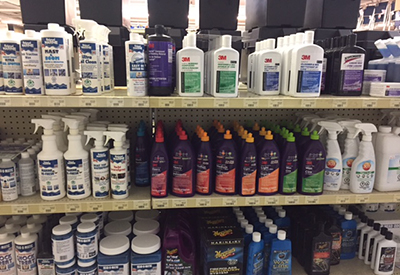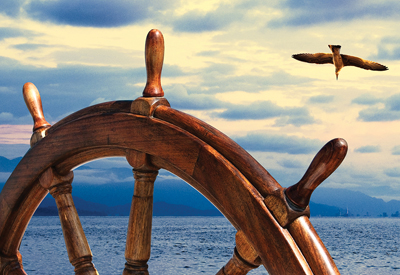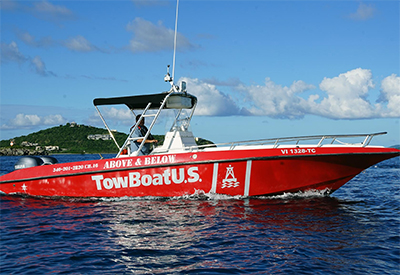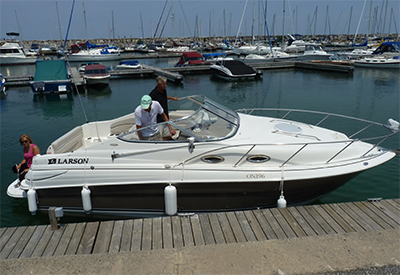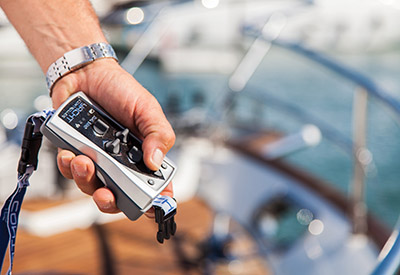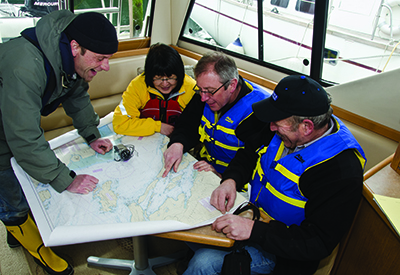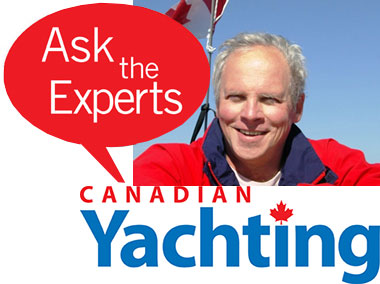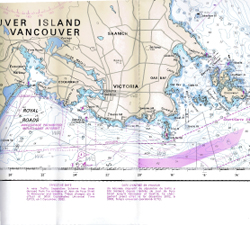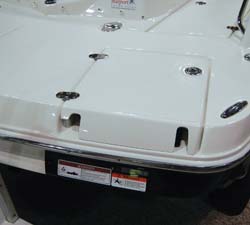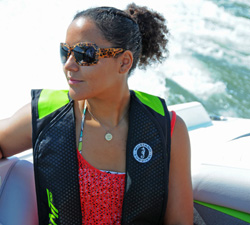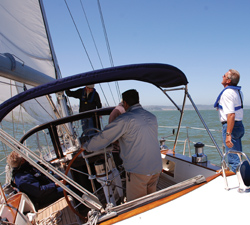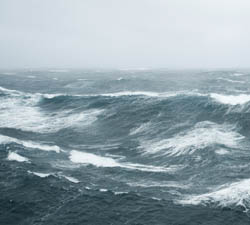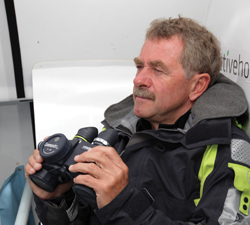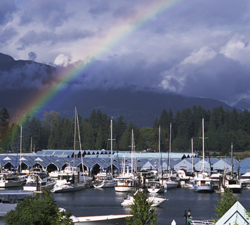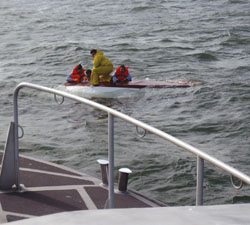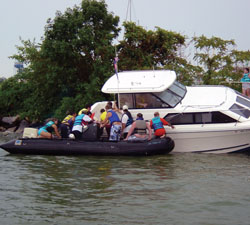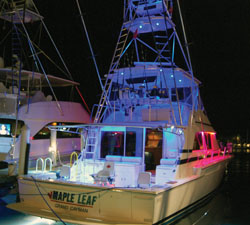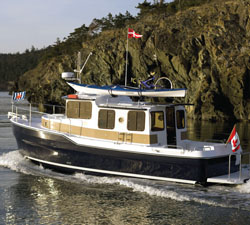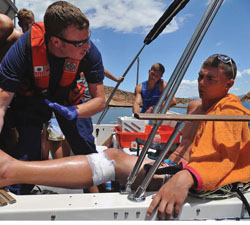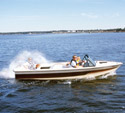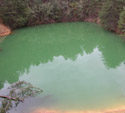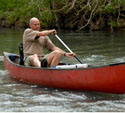May 24, 2017
Barrie marks Safe Boating Week
Every year, to mark National Safe Boating Awareness Week, the Barrie Power and Sail Squadron enlists the assistance of the Office of the Barrie Mayor to raise local awareness.
May 10, 2017
Ask Andrew: Canadian Tire or marine store – which do I choose?
Question: Can I buy generic automotive parts or products for my boat, or should they specify ‘marine’?
May 5, 2017
How to Aim Your Boat
How often have you seen boats weaving their way across the water, unable to keep heading in a straight line? Maybe you have even experienced this snaking yourself.
March 31, 2017
Top Dead Centre
‘Top dead centre’ is the position of the wheel that allows you to steer your boat straight with no back and forth movement of the wheel. When the boat is moving straight, your drive(s) or rudder(s) is(are) straight.
January 10, 2017
New Boater-Assistance Service Opens on St. Thomas, USVI
In the Caribbean or heading there? Emergency help is now available.
August 31, 2016
Confident Sailor / Reluctant Sailor – Part 2: Getting Ready – Skipper and Crew
In this second of three parts, we will explore preparing for a longer cruise from the people side. Later, in the third instalment we will look at final preparation of the boat…
May 10, 2016
No More Captain Crash! Embarrassment-Free Docking
While docking a sailboat has remained largely unchanged over the centuries, power boat designs have changed dramatically, even over just the last four decades…
December 21, 2015
Docking and Close-quarters Manoeuvering Made Easy
Comfort and convenience are important factors both to keep boaters enjoying boating as well as to attract new people into boat ownership. Perhaps the most significant regular challenges for all boaters are docking and close quarters manoeuvering. Getting in and out of your slip or into the fuel dock on a busy day can be tricky, especially if the wind is up or currents are running. In 2005, Volvo Penta introduced their revolutionary IPS drive systems that included an industry first – joystick docking.
November 19, 2015
Seamanship – Knowledge Is Power
We’ve all heard this before but it’s especially true when it comes to boating– knowledge is power. It is the power to confidently take your boat out with a load of passengers, go on longer trips, into unfamiliar waters, or even to navigate on your own to distant ports – that is the power of knowledge. The Canadian Power and Sail Squadrons, (CPS-ECP) offers a wide range of courses from introductory level to advanced and everything in between. Always focused on boating safety, the Canadian Power and Sail Squadrons, (CPS-ECP) have been empowering recreational boaters with knowledge for more than 75 years in Canada. Most of their courses are offered through the off-season when Power Squadron members themselves are unable to be out on their own boats.
May 27, 2015
Ask the Experts – Sacrificial Anodes
When metals are immersed in water and in close proximity to each other they produce an electrical voltage. When two dissimilar metals are in contact they form a galvanic cell, just like a battery.
April 23, 2014
The Future of Paper Charts
Will traditional paper charts soon be a thing of the past? And what will that mean for recreational boaters?Last fall, the National Oceanic and Atmospheric Administration (NOAA), the source for official US government nautical charts, abruptly announced it would no longer distribute lithographic nautical charts as of April 2014. The printer of NOAA charts, the US Federal Aviation Administration (FAA), made the decision to stop printing charts after the US budget shutdown last September. Is this the beginning of the end of paper charts as we know them? Will printed charts from the Canadian Hydrographic Service (CHS) be next?
February 18, 2014
See and Be Seen At Night
Navigation light repairs and replacements you can do yourself.In researching this article, we spoke to a number of marine industry professionals and started by asking, “Have you ever noticed boats on the water at night with incorrect or missing lights?“Or none at all!” was the frequent response we got as people laughed out loud about how common it is for navigation lights to be faulty.
December 30, 2013
`Boating Oops Awards 2014
What’s the dumbest thing you’ve ever done while boating?That’s the question I asked fellow-boaters over the past year. About half reported some real doozies, while the rest reported minor mishaps such as running out of gas in their dinghy or losing their winch handle overboard. Accidents happen to the best of us. The key to happy boating is to learn from our mistakes and the mistakes of others so we don’t repeat them.
August 19, 2013
Don’t Go Out Unless You Can Get Back In – Reboarding Ladders
It’s been a long time since I went for an unexpected swim, but it’s happened to me before and it will probably happen again. While losing your balance and hitting the water is bad (really bad if you are carrying an arm load of valuable things), clearly there should be an expectation that this may happen and every boat builder should aptly equip their boats to facilitate reboarding by a person who has fallen overboard.
August 2, 2013
Those Deviants Aboard Your Vessel
Deviation. Just the sound of that word makes you think that something fishy is going on; some deviant behaviour is taking place onboard your vessel that you can neither see nor hear. It’s there and if you don’t take heed, it will bite you in the backside and usually when it’s a dark and stormy night. So what is it? It is the effect on your magnetic compass from all those metal parts (i.e., engine block, steel tools, electronic gizmos such as radios and wiring) and various magnets (i.e., speakers, electric motor armatures).
May 13, 2013
Staying Afloat: The Power of PFDs
Intrepid CY volunteers dive in to test the latest PFDs – and find that comfort and style make them more wearable than ever. Is it just my imagination – or are more boaters wearing PFDs more of the time today than they used to? It has been reassuring over the past few years to see life jackets, inflatables, floater garments and similar life-saving gear being worn regularly in settings where the sight would have been rare a decade or two ago.
March 8, 2013
Perfect Docking…Every Time
Effective communication is the key to smooth, stress-free docking. I am an extraordinarily lucky guy. My wife Corinne is the skipper of our American Tug 41, Ocean Mistress, and she loves and excels at her job! I am completely delighted when we bring the boat into a difficult docking situation and make the perfect no-fuss, no-stress landing. I’m even more tickled when folks on the dock see Corinne come out of the pilothouse and are surprised to learn that she just docked that big boat. She has received everything from whispered compliments to standing ovations.
February 6, 2013
Boating Ed
Whether you’re a novice or an experienced boater, nothing helps build competence and confidence like boating courses and instruction. There’s nothing like being out on the water, spending time with family and friends, letting the wind fill our sails and whisk us away to new adventures. Or if power is your preference, casting off and throttling up catch a few waves or discover a new destination.
January 4, 2013
Buying with a Yacht Broker
Whether you’re a new boater or an old salt, you have much to gain by trusting your boat search to a knowledgeable professional. I’m a bit of an evangelist when it comes to boats – I believe that if you’re lucky enough to live near water, salt or fresh, owning a boat is the true meaning of life. I’ve never given up the faith, but after owning the same 35’ sloop for 30 years, things had changed. With two teenage boys who had somehow grown big, the space aboard Sway had grown small.
September 17, 2012
Falling for Fall – Fall Cruising Tips
Summer may be fleeting but the rewards of autumn cruising include a slower pace, quieter destinations, surprisingly good weather, and maybe even a few thrills. The full moon rose big and bright, its track shimmering across the water into our anchorage near the head of Salt Spring Island’s Long Harbour. Golden lights winked on one by one in the cottages around the bay, reminding me that I wasn’t completely alone. After a precious sunny, almost-warm late-autumn day, it was one of the most beautiful evenings I’ve ever spent on the hook. It was also one of the coldest, for we had yet to install a heater in our 27’ sailboat Squid.
September 17, 2012
BC Sailing Leads The Way To Safer Racing
The golden thread that links the aftermath most offshore and distance sailing accidents is the absence of formal safety and survival training. Despite the overwhelming body of evidence that supports that conclusion, North American sailors have been slow to embrace the idea that taking a course and learning how to right a capsized liferaft, proper tether and harness discipline, or how to retrieve a crew overboard from the water is just as important as investing time to teach how to tack without losing boat lengths. For racers it boils down to this: you cannot place if you don’t finish.
May 2, 2012
Financing Your New Boat
2012 is the Year of The Boat Buying Trifecta: Low Interest Rates – High Canadian Dollar – Low Global Boat Prices. We think that the 2012 will be the year of the boat buying trifecta; we have record low interest rates, a high Canadian dollar, and low global boat prices making the yacht of your dreams more affordable and closer to reality than we ever remember before. With rapidly escalating numbers of Canadians reaching retirement age, many of whom are already smart enough to have realized this opportunity, the Canadian boat market is alive and well while markets in most other countries are stagnant or down.
April 27, 2012
Marine Binoculars: A Shopper’s Quick Guide
While the Office of Boating Safety, Transport Canada surprisingly does not list binoculars as part of its mandatory safety equipment, we would suggest that having a good pair on board just makes good sense. Binoculars designed specifically for marine use are traditionally stronger in structure and are, of course, waterproof – or should be. In fact, some models even float. Today, we are going to highlight the key criteria for selecting a pair of binoculars as well as share a few neat features and accessories.
April 26, 2012
Great Resources for How to Weather the Weather
I’ve been a pilot for 37 years and spent 28 years flying passenger aircraft for the airlines – you can bet that the weather was always one of my foremost concerns. I’ve retired from the airlines, but my interest in the weather, in forecasting weather and in all of the available resources to help me plan a safe journey, are just as important as ever. It’s still a matter of my personal safety, the safety of my loved ones and my friends, except now, I’m at the helm of my own boat.
March 21, 2012
Starting – A System To Help You Get Off The Line With Confidence
Discipline is paramount in implementing a total starting strategy for each and every boat race. Without a sound understanding of the procedure by every team member on a boat, and allowing time to gather information before the start of every race, your chances of making well calculated decisions are substantially reduced. Many different sailors and teams have their own ideas and plans for the start of the race. The guide outlined here is a system that works well for me and you may find that modifying this works better for you – but the only way to establish this is to start practicing and sticking to a plan from the outset.
March 6, 2012
Have More Fun Next Summer With Greater Knowledge
Even if you were born on board a boat, there’s probably more knowledge and skills you could gain to help you have more fun next summer. Whatever your interest might be, whether you are a novice hoping to get started or you’re already an expert, there are many learning resources available. At Canadian Yachting magazine, one of our most important partnerships is with the Canadian Power and Sail Squadrons (CPS). If you’re new to boating and don’t know about CPS, they are a national organization, operating in both official languages and they are all about boating knowledge.
October 18, 2011
Surviving a Capsizing
Capsizings resulted in many recreational boating deaths and injuries in 2010. Practice good seamanship to reduce your risk of capsizing, but if it happens know what to do to ensure that everyone on board gets back safely. If you and your passengers are not wearing life jackets when the boat capsized, try to retrieve any equipment or gear, such as coolers or seat cushions, and improvise flotation. Never attempt to re-enter a capsized vessel. Then consider the most appropriate means to summon help.
October 18, 2011
5 Key Factors in Ensuring a Safe Rescue
This past May, Coast Guard surface and air crews conducted an all-night search of the Great Peconic Bay area of Long Island, NY, for a possible missing kite surfer after gear was found floating in the water. The search was suspended after news reports prompted the owner to call to say he was safe. Coast Guard patrols often encounter abandoned and adrift boats and gear. If there is even a small chance a person is in the water, the Coast Guard undertakes search and rescue efforts. If you should find yourself in trouble, here are five actions you can take to increase the chances Search and Rescue will get to you in time.
October 18, 2011
Lighting the Way
So, who’s afraid of the dark? Well, some boaters should be. We were surprised to walk down the docks at one of Georgian Bay’s popular marinas and found that as many as one boat in five didn’t have a bow mounted spot. How often have you seen the weather settle down, the clouds part and the winds die down to give you an evening of beautiful, calm, sunset cruising conditions? Where I live, it’s pretty common.
October 18, 2011
Flag Etiquette: Flying Flags and Pennants Properly
A number of weeks ago I received an e-mail from a Canadian who owned and operated a recreational boat in the U.S. The boat, for the most part, stayed in U.S. waters and was licensed in a U.S. State. The owner wanted to know where he could fly a Canadian flag to indicate his citizenship. The simple answer was that he could not, if he was operating in U.S. waters. The National flag indicates the Country of registry, or where the boat is licensed, in this case the U.S. A courtesy flag indicates where the vessel is being operated, for the most part, also the U.S. These flags do not indicate the citizenship of the owner/operator.
August 23, 2011
First Aid and Hero Training
No one plans for an accident to happen while boating, but if it did, are you prepared? Is there a first aid kit on board? Is it easily accessible and fully stocked? Does anyone on board even know how to use it? Could you be the hero, or will you be just a bystander? Safety can be a hard sell. In Vancouver, Western Marine Company’s Alan Stovell said simply, “There is no requirement for first aid kits for recreational boaters.” He points out while commercial boaters must abide by strict regulations based on the crew and voyage there are no such restrictions for pleasure boaters in Canada, although it’s certainly recommended.
July 12, 2011
Travelling South of the Border
For those of you who boat south of the border, the following information bulletin was recently issued by U.S. Customs and Border Protection regarding a new program to permit easier entry of pleasure craft into the U.S. “The Small Vessel Reporting System (SVRS), a voluntary program offered by U.S. Customs and Border Protection (CBP), helps boaters report their arrival to the U.S. at no charge. The program is designed to expedite entry of legitimate boaters,
January 5, 2011
Insidious Carbon Monoxide
It’s difficult to comprehend that when we head out on the open water, with a fresh breeze, clear air and nary a boat nearby we could be a victim of something we usually associate with confined spaces and poor ventilation–Carbon Monoxide (CO). Onboard our vessels, we have a few potential sources of CO such as gasoline-powered engines and generators and propane cooking and heating appliances. Exhausts should dissipate harmful gases away from the boat, however experts in occupational health and safety, search and rescue and ambulatory care are identifying emerging issues for boaters.
December 30, 2010
The Aids To Navigation System
There’s nothing like that picturesque lighthouse flashing a light on a high cliff with pounding surf on the rocks below it. That large bell buoy clanging away in the swell just offshore from the breakers crashing on a shoal and the groaning foghorn blaring through the heavy mist to warn of landfall somewhere in the pea soup. Those certainly are the traditional icons we may all imagine when mention of aids to navigation is made but are they accurate in today’s technical world? And not withstanding today’s technology, how did and do the traditional aids actually help a mariner navigate safely?
December 23, 2010
“Water” Safety
Many of us unwittingly know a few words of Samuel Coleridge’s epic poetic story, The Rime of the Ancient Mariner. The words that are often quoted, though their source is seldom acknowledged, refer to being far away on the briny ocean tossed and go like this: water, water everywhere, ne any drop to drink.
December 17, 2010
Safety On Board
Transport Canada regulations require vessels to carry a variety of life saving equipment for use in emergencies. Make sure you know where this equipment is stored, and how to use it. For specific regulatory requirements, check the regulations that apply to your vessel. The Small Vessel Regulations set out the minimum safety equipment required on board a recreational boat according to vessel length.
November 4, 2010
The Art of (Paper) Charts
They decorate cottage walls, get lacquered into table tops, may have coffee stains, probably have water stains, are definitely creased, sometimes rolled and always informative. They are usually only printed with a few colours of ink, mostly one sided, regularly cover about 12 sq. ft. and are chock-a-block full of details for navigation and often inscribed with an ‘X’ that marks the spot.
June 2, 2010
Can You Canoe?
The canoe. Now that’s Canadian. They have been part of the landscape from since native North Americans plied the waterways to now being one of the most economical and accessible ways to get out on the water and explore. They seem simple enough – grab a paddle and go. Eagerly purchased, usually incompletely outfitted and almost never really understood or mastered. After a season or two, many a forgotten canoe can be found behind garage’s, under porches at cottages or at the boat ramp, gathering critter droppings and moss. But every once and a while a desire to get out on the water arises and someone remembers the Canadian icon, ignominiously hidden away. They haul it out, grab a paddle and go.


